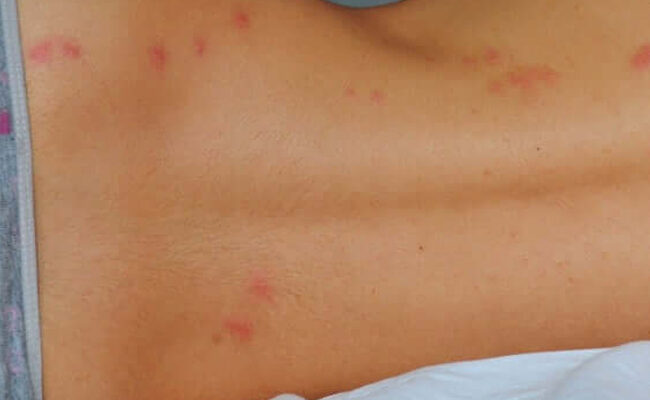
Bed bugs are parasitic insects that will feed on the blood of humans and other warm-blooded animals. They live in cracks and crevices, mostly in bedding or furniture near where people sleep. Bed bugs have been known as a persistent pest problem since at least medieval times!
How to identify a bed bug bite?
When the bugs bite, they end up injecting an anesthetic and an anticoagulant which stops someone from ever recognizing they are being bitten. This typically causes an itchy welt that can be visible on the skin. These bug bites are different from other small insect bites because they often occur in clusters or lines of two or three bites. You may not know you have a bed bug infestation if they are feeding while you’re sleeping. Bed bugs leave behind small blood spots on sheets and pillowcases but can sometimes be challenging to spot.
How do you prevent bed bug bites?
You may not prevent bed bug bites because the areas where bed bugs hide may not always be in your control. However, you can avoid bed bugs if you avoid buying second-hand beds and sofas and thoroughly inspect the places where you sleep before bringing them into your home, especially if they were stored or transported in a container such as a van.
How do you treat bed bug bites?
Bedbugs are not commonly known to transmit any diseases, but their bites can cause allergic reactions and irritations. They’re at their most active about an hour before dawn when they prefer to feed on non-human blood. Since the bed bug’s bite is painless, many people do not know that they are being bitten.
If your bites are causing you issues, it’s essential to consult a doctor if you suspect bed bugs have bitten you. A doctor will confirm whether or not you have been bitten and can prescribe medication, such as antibiotics, to prevent infection and treat the irritation.
Signs of an infestation
If you suspect you have a bed bug infestation, there are some signs you can look out for in your home to see if they are there. Bed bugs tend to leave behind dark spotting of varying sizes on sheets and mattress seams. They also leave rusty-colored blood spots on the surface of mattresses where they feed. These tiny blood spots will usually be accompanied by the bed bugs themselves, as they tend to be slow-moving and sluggish.
How to prevent and treat an infestation
The most effective way to treat bed bug infestations is with the use of professional help. However, there are some effective remedies you can try at home, which may help you get rid of the problem.
Extensive vacuuming of floors, carpets, and cracks where bugs might be hiding can remove a substantial portion of bugs and eggs; repeated vacuuming over several days is recommended. Steam cleaning of carpet may be more effective than hot water alone in killing bugs and eggs, but steam cleaning will not eliminate an infestation.
Washing bedding at high temperatures helps kill bugs on textiles. Use the hottest cycle on your clothes dryer to clean stuffed toys, pillows, and comforters. Dry cleaning kills bed bugs but does not prevent them from coming back.
Preventing future bites from happening
Once you have gotten rid of an infestation, you can take specific preventative measures to stop it from coming back.
There are sprays for both indoor and outdoor use that can help ward off bed bugs. First, spray your mattress with the rush to keep them away. However, this method isn’t 100% effective in keeping them away. You may want to use a mattress cover to prevent bed bugs from getting in. Using tightly woven, unbleached cotton sheets and pillowcases will also keep bugs away when sleeping.
When traveling, please keep all your luggage in the bathroom or tub when you aren’t there so bed bugs can’t hide inside them. If you suspect your luggage has bed bugs, put it in a trash bag and leave it outside for at least a day. Once you return home from your trip, wash and dry your luggage in the hottest setting to kill any bed bugs. Also, clean and dry your clothes on high heat as soon as you get home from traveling. This will help kill any possible bedbugs that might be on your clothing.
Professional help is the most effective way of removing bed bugs.
These bugs are notoriously difficult to exterminate, and the process is often long and tedious. In addition, as bed bugs can live in sofas, carpets, and other places in the home, it may sometimes be challenging to find all the bugs. However, professional help can identify these areas where they are living so that you can eliminate them.
Professional exterminators will often use strong insecticides to treat your home. One drawback is that using these chemicals without care can damage your home. Another option would be to use a natural, non-toxic solution from a bed bug barrier.
The best method is prevention: use a mattress cover and seal it shut to prevent bed bugs from getting in or out. You can also raise the legs of your bed on pieces of wood to stop them from climbing up into your bed.
Prevention is far the best way to get rid of bugs—keep your home clean and free of clutter, close off any cracks or crevices where they can hide, and seal up your mattress.
Leave a Reply